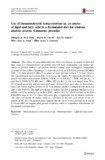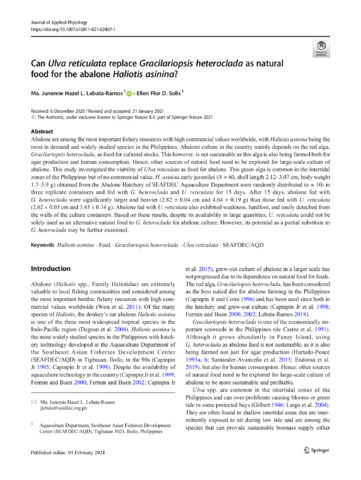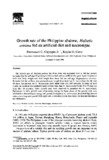| dc.contributor.author | Lebata-Ramos, Ma. Junemie Hazel | |
| dc.contributor.author | Solis, Ellen Flor | |
| dc.contributor.author | Biñas, Joseph B. | |
| dc.date.accessioned | 2023-01-30T02:47:27Z | |
| dc.date.available | 2023-01-30T02:47:27Z | |
| dc.date.issued | 2023-01-27 | |
| dc.identifier.citation | Lebata-Ramos, Ma. J. H. L., Solis, E. F. D., & Biñas, J. B. (2023). Seaweed Gracilariopsis heteroclada, formulated flaked diet, and a combination of both as feed for the abalone Haliotis asinina: Effect on growth and survival. Aquaculture International, 31(4), 1995–2009. https://doi.org/10.1007/s10499-023-01069-9 | en |
| dc.identifier.issn | 0967-6120 | |
| dc.identifier.uri | http://hdl.handle.net/10862/6412 | |
| dc.description.abstract | This paper compares the effect of feeding the abalone Haliotis asinina with seaweed (SW), formulated (FD), and mixed (SW+FD) diets. The feeding experiment, in six replicates, was conducted in a tank facility and lasted for 10 months. At the end of the experiment, abalone fed mixed diets had significantly the highest mean shell length and body weight (45.90±0.19 mm, 22.82±0.31 g), followed by those fed seaweeds (43.47±0.17 mm, 18.25±0.26 g), and lastly, by those fed formulated diets (41.78±0.18 mm, 15.76±0.22 g). Mean growth rates were significantly higher in abalone fed mixed diets at 1.48±0.03 mm and 1.69±0.04 g mo−1 than those fed seaweeds (1.26±0.03 mm, 1.27±0.06 g mo−1) or formulated diet (1.06±0.09 mm, 1.00±0.11 g mo−1). Survival was consistent 1 month from the start of culture until harvest—highest in abalone fed mixed diets (78.81±2.48%), followed by those fed seaweeds (70.12±4.07%), and lastly formulated diet (64.53±4.61%). Moreover, feed conversion ratios (FCR) were significantly lower in abalone fed mixed diets (15.48±0.69) and formulated diet (18.07±3.50) compared with those fed seaweeds (41.31±2.36). The body weight to shell length ratios (BW:SL), which were the same in all treatments at the start of the experiment (0.19 g mm−1), increased to 0.51, 0.44, and 0.38 in abalone fed mixed diets, seaweeds, and formulated diet, respectively. Based on the results of this experiment, giving abalone a mix of formulated and natural diets is the best feeding regime. The importance of a balanced and more nutritional diet on the well-being of the abalone was observed in this study. | en |
| dc.description.sponsorship | The authors greatly appreciate the Southeast Asian Fisheries Development Center Aquaculture Department (SEAFDEC/AQD) for funding the study (Study Code: FD-04-M2020T). | en |
| dc.language.iso | en | en |
| dc.publisher | Springer | en |
| dc.subject | Abalones | en |
| dc.subject | Haliotis asinina | en |
| dc.title | Seaweed Gracilariopsis heteroclada, formulated flaked diet, and a combination of both as feed for the abalone Haliotis asinina: Effect on growth and survival | en |
| dc.type | Article | en |
| dc.citation.volume | 31 | |
| dc.citation.issue | 4 | |
| dc.citation.spage | 1995 | |
| dc.citation.epage | 2009 | |
| dc.citation.journalTitle | Aquaculture International | en |
| dc.subject.asfa | abalone culture | en |
| dc.subject.asfa | feeding experiments | en |
| dc.subject.asfa | feeds | en |
| dc.subject.asfa | growth | en |
| dc.subject.asfa | survival | en |
| dc.subject.asfa | seaweeds | en |
| dc.identifier.essn | 1573-143X | |
| dc.identifier.doi | 10.1007/s10499-023-01069-9 | |
| dc.subject.scientificName | Haliotis asinina | en |
| dc.subject.scientificName | Gracilariopsis heteroclada | en |
| local.subject | Haliotis asinina | en |
| local.subject | Abalone | en |
| local.subject | Gracilariopsis heteroclada | en |
| local.subject | Formulated flaked diet | en |
| local.subject | SEAFDEC/AQD | en |
| local.subject | donkey’s ear abalone | en |



